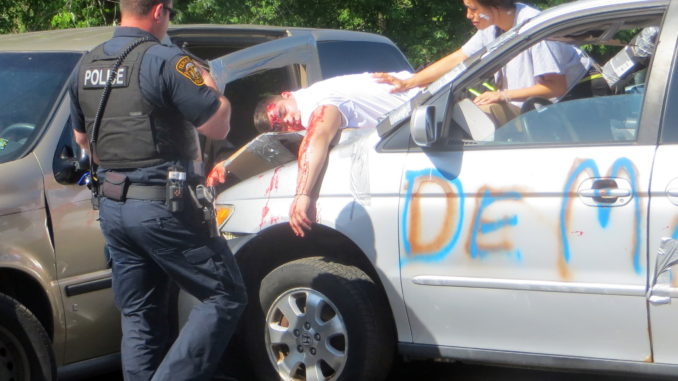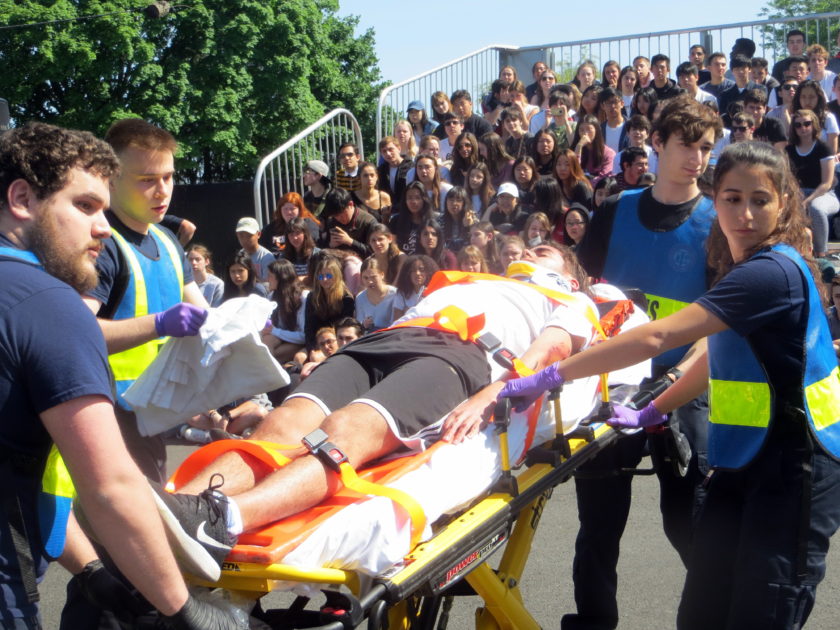
TENAFLY, N.J.—On May 22, Tenafly High School (THS) juniors and seniors witnessed a hair-raising scenario demonstrating the dangers of drunk and distracted driving.
As they sat in the bleachers near the school’s athletic field, several hundred students saw THS senior Isaac Berman sprawled out unconscious on the hood of a car that had been in a horrific crash. He was covered in blood and broken glass.
Gili Zaifman lay in a second demolished car, dripping blood and barely breathing. Other THS students, Alessandra Bontia, and Guy Maslaton were also injured in the ill-fated crash and Anya Kasubhai called 911 screaming for help.
Within minutes, an ambulance and two Tenafly police cars pulled up to the scene with their sirens blasting. They were soon followed by two fire trucks carrying 11 firefighters. The joint rescue team sprang into action, securing the scene, providing medical support and evacuating the victims.
As police officer Louis Smaragdakis asked Kasubhai detailed questions about the accident and gave her a sobriety test, firemen broke into car windows with Jaws of Life equipment to extricate trapped survivors. Neck collars were used on supine victims to prevent spinal injuries. Zaifman was carried out on a gurney and evacuated in an Airbus H125 helicopter to Hackensack Hospital and Medical Center. Berman, who had been thrown from the back seat of a car through the front windshield, was pronounced dead at the scene.
This horror story that no one should have to see in real life was the final segment in Tenafly High School’s program on Prom Safety. “The goal of a simulated crash is to educate our students about the tragedy of traffic crashes—and to reinforce the importance of paying attention behind the wheel and to show the consequences of drinking and driving,” said Principal Jim Morrison.

With the senior prom scheduled to take place that evening, the timing and impact of the program had maximum impact.
The Prom Safety Program began earlier that morning in the school auditorium.
It was organized and led by physical education/health teacher Kristen McCall, physical health/driver’s ed teacher Deana Salamone, the School Resource Officer (SRO) and Joe Solda from AirMed 1, a paramedic helicopter, and included several guests speakers.
At 9:45 a.m., there was a welcome by Principal Morrison. He went on to recount a prom incident that took a disastrous turn. A group of students were driven after their prom in an Uber car, and the last person to be dropped off was a girl. She had fallen asleep, and when she woke up she was in front of her house in Alpine and the Uber driver was on top of her sexually assaulting her. The driver was arrested and pleaded guilty and is now a registered sex offender.
“The lesson to be learned from this,” Morrison said, “is that the girl should have stayed at someone’s house and not have been left alone in the car as the sole passenger late at night. You should stay together, be aware of your surroundings, know where your friends are and know where you are.”
Following Morrison’s remarks, the first guest speaker was Sarah Monchar, a trauma critical care physician assistant, and manager of the trauma service at Hackensack University Medical Center. Monchar gave some eye opening statistics about teen drinking and texting car accidents. She said that in 2016, 2,430 teens in the United States ages 16 to 19 were killed and almost 300,000 teens were treated in emergency departments for injuries suffered in motor vehicle crashes.
Monchar said drivers 16 to 19 are nearly three times more likely than drivers 20-and-over to be in a fatal crash. Teen deaths in car crashes are related to alcohol 60 percent of the time, she said. Newly licensed teens have the highest risk of car accidents, teens have the lowest rate of seat belt use and they are 400% more likely to have a distracted driving crash than adults.
Monchar also briefly touched on the opiate crisis, citing the rise in heroin and fentanyl use and noting that New Jersey has hit a record high for the fourth straight year. She mentioned the Good Samaritan Law that protects people who report emergencies and urged the students to immediately call for help and report such incidents involving their peers.
The next speaker was Joe Carollo, THS Athletic Director and Supervisor of Health and Physical Education, who related a heartbreaking personal family experience of how one person’s poor choice changed everything. Seventeen years ago, Carollo’s 24-year-old brother-in-law, Michael died in a car accident while intoxicated.
“He didn’t just take his life that night. He took the life of my mother-in-law, my father-in-law, my wife and myself. Afterwards, no one was ever the same. What was really sad is that for years, everyone knew that Michael had a drinking problem, but no one intervened,” said Carollo.
The next speaker was Officer Brandon Moriarty of the Tenafly Police Department. He reinforced the motto—“See Something, Say Something.”
“According to the Centers for Disease Control and Prevention, there are over 300,000 incidents of drinking and driving each day,” said Moriarty. “An arrest doesn’t typically mark the first time a person drives under the influence: The average drunk driver does so over 80 times before getting caught. Alcohol related traffic collisions and driving distractions are a major social, health, and economic problem. In 2015, in NJ alone, 67% (6,865) were in crashes in which at least one driver in the crash had a blood alcohol content of 0.15% or higher. That is almost double the legal limit.”
Moriarty also spoke about the problem of driving and texting.
“Drivers under the age of 20, not only are avid text message users, they make up 27 percent of the drivers in fatal crashes that were attributed to distracted driving. Every day, 11 teenagers die because of texting and driving. These statistics fuel the need for proactive measures by every community.”
Moriarty then told the students that they were about to witness a driving under the influence/distracted driving reenactment.
“This re-enactment is to focus on a comprehensive health approach which challenges you to think about preventative measures when getting behind the wheel of a vehicle. This community cares about you and hopes that this is a message and a lesson that you learn and take seriously over the next hours, days, weeks, months and years.”
The seniors then walked out to the senior parking lot near the school’s athletic field where they were joined by the junior class to witness the car accident reenactment.
It began with the SRO reciting the call information over the loud speaker at the scene of the accident.
The tarps covering the two vehicles were then undraped and the gory scene came to life, eliciting gasps of horror and disbelief from the spectators.
The scenario was played out from the initial 911 call through the ambulance and helicopter evacuations. Afterwards, students were given a vital takeaway message, urging them to reflect on how poor decisions can lead to injury, prison, or even death.
